While the term “pith helmet” is commonly used to describe any sun or summer helmet, it isn’t exactly accurate. Pith has entered the lexicon much as “Xerox” means “photocopy” or “Kleenex” means “facial tissue” – at least in English. The difference is that while some corporate brands have become generic terms, pith is not a brand but a material.
However, a “pith helmet” has come to be a style of helmet as well. In that regard, at least as in the style, the term is accepted. But it must be stressed that not all “pith helmets” are therefore constructed of “pith.” In fact, many “pith helmets” are actually made of cork, but pith and cork are not one and the same – and despite some simplified explanations in books on military headgear, pith isn’t even a type of cork.
The materials are dissimilar in where they are grown, how they are harvested and even in the part of the plant where the materials come from. The only thing in common is that both are plant based. Beyond this pith and cork are quite different.
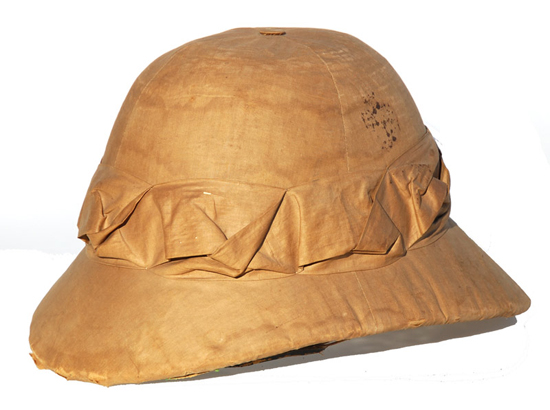
A Hong Kong made “sola pith” helmet. Note how the helmet appears somewhat “thick?” This is because sola pith is a soft material that is reinforced with wicker and even paper.
Pith, also known as medulla, is a tissue in the stems of vascular plants, and comes from the center or spongy inner layer of the rind. The type of pith from “pith helmets” specifically comes from the sola plant, also known as the aeschynomene aspera.
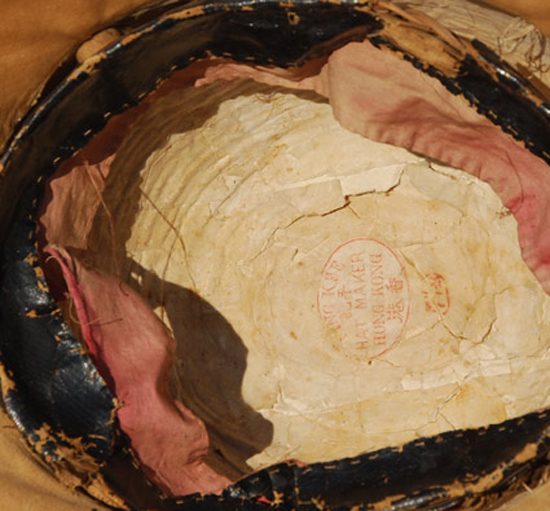
The inside of the Hong Kong made helmet shows the white “sola pith” material, which remains somewhat spongy to the touch.
This is quite different from cork, which is prime-subset of bark tissue, which is removed from the outside of the cork oak tree. Thus the two materials have virtually nothing in common, except again being plant-based. To add to the confusion Cork Oak has nothing to do with “cork trees,” which do have a corky bark but aren’t in fact used for cork production.
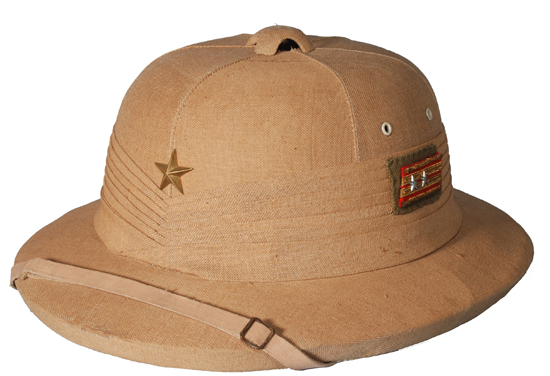
A World War II era cork helmet. While sola pith was more common in the Far East, the Japanese military adopted helmets made of a variety of materials including pith.
Sola pith is actually harvested with the entire plant being utilized to obtain the material, while cork is stripped from the outside of cork oak tree. Oak cork trees can live for 200 years or more, but must be at least 25 years old before the cork can be stripped, and subsequent harvests can then occur again only every 10 years. The first two harvests from a tree typically produce poorer quality cork, but quality generally improves over time.
Because of the long growth cycle conservation is key in cork production, and thus cork “forests” are maintained, which in turn insures that species living in the forests are protected by default.
While helmets are obviously made both of pith and cork, it is interesting that term “pith helmet” came to be the generic name for this particular headgear. The reason goes back to the origin of the helmets – namely India. And the reason for the confusion can be summed up quite easily.
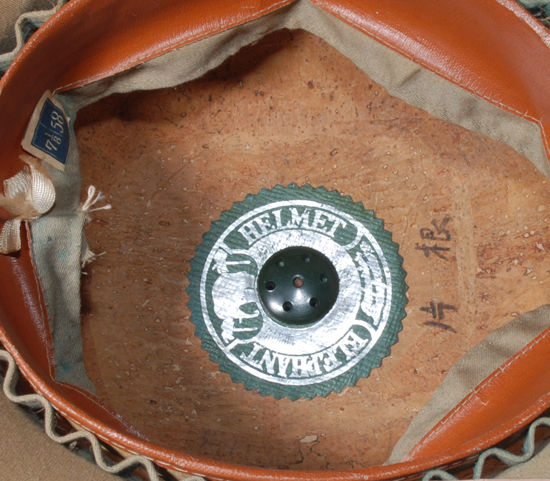
The inside of the Japanese helmet shows exposed cork, which clearly is quite different from sola pith
Colleague Doug Zinn, an advanced collector of sun helmets explains:
“Pith is not a type of cork. Pith comes from the plant aeschynomene aspera. This material was used – and still is – as floats for fishing nets, elaborate tiny sculptures, insulators, It is a very light material, however, not as resilient as cork. Although there were British made pith helmets, the majority were manufactured all over Asia, with the greatest production in India. All colonial powers wore helmets made of pith, however, primarily for civilian use. The British and Indian Armies wore pith and cork, of course, and one can find them worn by other colonial powers.
“English vernacular has embraced the terms “pith helmet” as the catch-all for any sun helmet. In some way, it’s like people using Kleenex for all facial tissue. Also, people use “solar topee” and the actual Hindi is “sola topee”, sola referring to the pith plant and topee meaning hat. The public changed “sola” to “solar” for sun. Language is a constantly evolving tool.”
This brings us back to the point of “pith” vs. “cork” as the name. As the helmet pattern was in essence born in India and grew out from there the name stuck, and became the generic term for sun helmets.
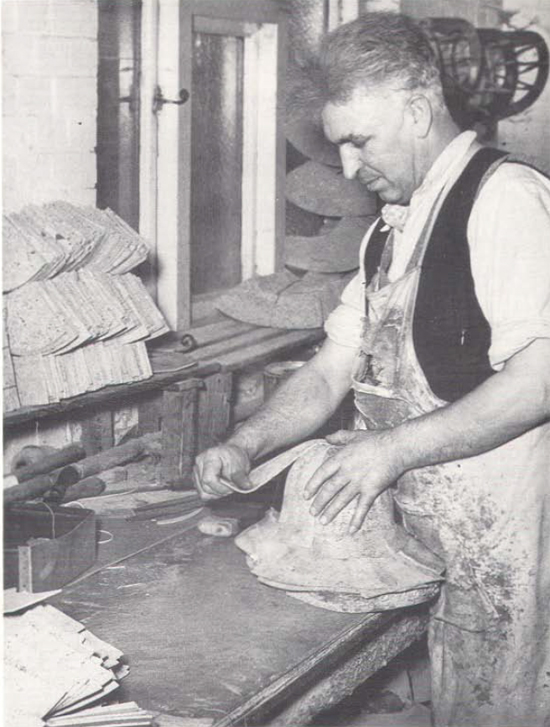
A vintage photo of a cork helmet being produced, this process involved sheets of cork that were shaped on a block and glued together. This process was known as knocking-on. The rough shaped shells then went to a blocking machine to refine the shape of the helmet before being covered with the canvas fabric.
And about the use of materials? That can be summed up by geography as much as anything else. Aeschynomene aspera – sola pith – is native to Bangladesh, Bhutan, Cambodia, India, Indonesia, Laos, Malaysia, Myanmar, Malaysia, Nepal, Pakistan, Sri Lanka, Thailand, and Vietnam. It is an aquatic plant and considered a minor weed as it typically can spread into rice paddies in the region.
Fortunately, a use was found for the fast growing, quick spreading plant. It was used to make hats, which of course evolved into the early sun helmets used by the British forces in India, including the Honourable East India Company.
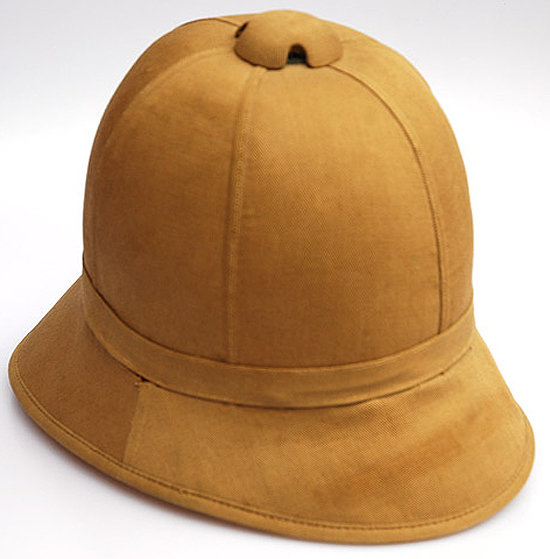
A Spanish sun helmet, made of cork, from the Spanish-American War. Few of these survived as the Spanish burned most of their uniforms for fear of bringing Yellow Fever back to Spain from Cuba. Note that this helmet’s body is far thinner than the sola pith helmet.
By contrast the majority of cork is produced in Portugal and Spain, with a bit less from Italy. This helps explain, at least in part, why European made sun helmets were made of cork and not sola pith. As many military outfitters were still based in Europe the native materials were utilized as these were closer and easier to obtain.
Thus by the outbreak of World War I the vast majority of British-made helmets, as well as those of France, Germany and Italy, were made of cork. Straw was a common substitute material. By contrast Anglo-Indian helmets, such as the Cawnpore, Bombay Bowler and later the Khaki Sola Pith hat were still made of sola pith.
An interesting side point is that one pattern of Portuguese sun helmets – actually those that were originally designated for use by the Metropolitan Army of Portugal and meant for use domestically, but then used in Africa – were made of pressed felt rather than cork.
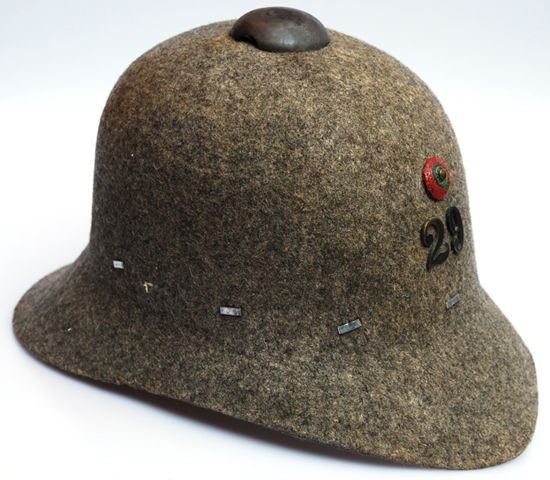
A 1913 pattern Portuguese pressed felt helmet. While intended for use in Europe, these were used as sun helmets in Portugal’s African colonies.
The reason is that the Portuguese government, which faced a financial crisis in the years leading up to World War I actually couldn’t afford to buy cork, which was a valuable export product, and opted to use the cheaper pressed felt!
Today, sola pith helmets are still made in India and Pakistan, and cork helmets are still made in Europe. Other materials, including pressed fiber, pressed felt, wicker, straw and even plastics have been used to make the helmets. Regardless of what the material is, most people simply know these as “pith helmets.”
Peter Suciu

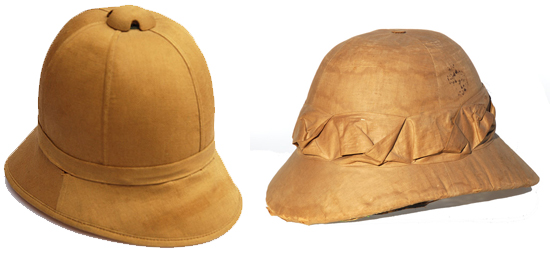
interesting. what is the zig-zag part inside made from?
The zig-zag part seems to be a pressed fiber of some sort. It seems to be a cloth covered material that has been hardened into shape. It is “flexible” in that it bends – or at least bended when the liner was installed.
How can one tell apart if a helmet is made from pith or cork then? I have a Kenyan made Bombay bowler and which one do African-made ones normally made from?
From what I saw here, corks look just like that, cork. Brown and dense, . Whereas pith are somewhat spongy, white, soft, a little loose consistency.
Regarding the Portuguese 1913 “pith” helmet:
Although economical difficulties did exist at that time, the reason this helmet is made of pressed felt had nothing to do with them. Portugal was, and still is, the world’s largest cork producer, and the option for this material would be, in fact, cheaper.
The real reason is that this helmet was never intended for Africa but for the Metropolitan Army. It was issued to the expeditionary forces sent to Africa (both Army and Naval Infantry) merely because there was nothing else to supply them with. It must be remembered that the conflict was a surprise, since hostilities began in 1914, while officially, war with Germany only began in 1916 (by that time only slouch hats were used).
Pedro Soares Branco
Hmmmm …. Perhaps my email is being moderated; I don’t see it. In case my comment was lost, I repeat it:
The Japanese army sun helmet belonged to a Lieutenant Colonel Katane 片根 [kata-neh].
–Guy Power
Hi Guy,
your comment was probably considered as spam, but who knows why? We do read all comments but I am not aware of any being removed unless they were spam that got through the checker.
Thanks for the information,
Stuart
Thank you very much for sharing this information and great photo samples of real helmets. Are there are any internal markings on the Spanish pith helmet? This helmet seems to be 1899 khaki model used by US troops during the occupation of Cuban, Puerto Rico and the Philippines. The Spanish model used in Puerto Rico was described as dark grey with a off-white cover that had an opening or slits to put the helmet frontal plate consisting of the Spanish Coat of Arms and cockade. The early models of the pith helmet used in India had crest that served as a ventilator. This same model was also adopted by the Spanish colonial army in the Philippines before adopting the new model with the upper “button” with three vents.
Hi Guys.
Great article but do you have any links to whomever is still making cork sun helmets in Europe?
Thanks,
Darwin
I have a 1940 family heirloom Victoria mounted police helmet which appears to be made from cork.
I am looking to have it reshaped as 75 years has left it a little imperfect.
Are there some simple instructions or is it a job for professionals?
Please can you tell me if there are any traditional helmet makers left, rather then the cheap reproductions around ? Regard Nicholas
where can i buy a real pith helmet? what is better? pith or cork?
As of today, August 2019, I do not know of any hatters still making sun helmets with cork, unless for XIXth Century reenactors and provided it is a group buy of no less tan 50 sun helmets… As for decent pith helmets available in the market, I would say that beyond buying vintage sun hats, which are often rather expensive and seldom in perfect shape, the best I have found is the current range sold by the brand Stetson under the names “Salonga” (Light grey color), “Daintree” (Beautiful dark beige or light Brown color) as well as the exact same hat sold by Lock & Co. Hatters of London (albeit at almost 3 times the price of the Stetson one (245 British Pounds(!) vs. around 100 $ for the Stetson versión, which can be found on offer these days with up to 50% reduction in some shops – I guess it is being phased out or discontinued). These hat is a nicer safari hat, but the interior is not exactly as it used to be 80 yers ago… Until recently, a shop aimed at reenactors, “WHAT PRICE GLORY” was selling a very nice WWII versión of the British Wolseley pattern pith helmet in light khaki green with a more realistic good leather sweatband and interior and very nice finish. I was able to get two helmets (at 60$ each) but they now seem discontinued. Otherwise, among the cheap ones made in Vietnam, which are not that bad, being made of real pith, the best one, IMHO, is the so-called Indian one. Best shape and most confortable one. The French one (recently sported by Melania Trump in Africa) is not particularly beautiful nor historically accurate (although it did not look so bad on Mrs Trump, aesthetically speaking), the Safari or African one, is rather similar to the India one, but with a more rounded Crown, making it less nice in shape, the Wolseley is not particularly accurate and the so called British or Foreign Service type (Zulu war and so) are quite wrong in shape, their proportions having more in common with French military helmets from the late XIXth Century. As for the vintage ones, the most easy to find are Bombay Bowler types made in India in the 1950’s and 60’s but mostly in the seventies, among others for US brands or shops like Banana Republic or Dorfman Pacific. Those are not too dificult to find on eBay, and are rather cheap, but, when new, are almost only found in Small or very Small (Boys and girls) sizes. They are decent, but rather modern, being made of pith, with cardboard or newspapers added and with some plastic elements sometimes (Ventholes, interior…). They are nevertheless real ones, intented for real use in the second half of the twentieh Century, but made in the same way as older ones, except for the odd pieces in plastic…